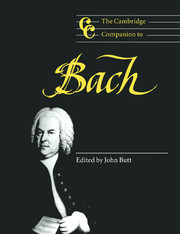Book contents
- Frontmatter
- Introduction
- Part I The historical context: society, beliefs and world-view
- Part II Profiles of the music
- Part III Influence and reception
- 12 Bach as teacher and model
- 13 Changing issues of performance practice
- 14 Bach reception: some concepts and parameters
- 15 Reinterpreting Bach in the nineteenth and twentieth centuries
- Notes
- Select bibliography
- General Index
- Index of works
15 - Reinterpreting Bach in the nineteenth and twentieth centuries
from Part III - Influence and reception
Published online by Cambridge University Press: 28 September 2011
- Frontmatter
- Introduction
- Part I The historical context: society, beliefs and world-view
- Part II Profiles of the music
- Part III Influence and reception
- 12 Bach as teacher and model
- 13 Changing issues of performance practice
- 14 Bach reception: some concepts and parameters
- 15 Reinterpreting Bach in the nineteenth and twentieth centuries
- Notes
- Select bibliography
- General Index
- Index of works
Summary
The second half of the eighteenth century: ‘adoption’ – ‘classical’ rephrasing – Mozart's image of Bach
The historical location of Bach in the music of the nineteenth and twentieth centuries and the accompanying radical changes are determined by his position in the second half of the eighteenth century. The caesura ‘1750’ could indicate a break in the influence of Bach's music, or the beginning of a tradition where it and his understanding of it are transmitted to his sons, students and future generations in a linear, undisturbed fashion, or, conversely, the beginning of the process of reinterpretation that is more familiar after the turn of the nineteenth century. Each of these three positions has consequences for the writing of music history in the second half of the eighteenth century and for the development of a ‘Romantic Bach interpretation’ in the early nineteenth century. In the first case, the phase 1750–1800 can be portrayed without Bach, which, given the minor influence of Bach's music on the general public, would be correct. In the second case, the preservation of the Bach tradition, there is the danger that the ‘shift’ of the divergent horizons of expectation, in Blumenberg's sense, would be exaggerated and the historical portrayal would be focused too much on the monument ‘Bach’. The third position has the advantage of differentiating between the ideas of breaking with the past and continuity and sees the process of reinterpretation during the eighteenth century as the decisive precondition for the means whereby Bach's music, once functional and rhetorical, now becomes autonomous.
- Type
- Chapter
- Information
- The Cambridge Companion to Bach , pp. 226 - 250Publisher: Cambridge University PressPrint publication year: 1997
- 12
- Cited by



